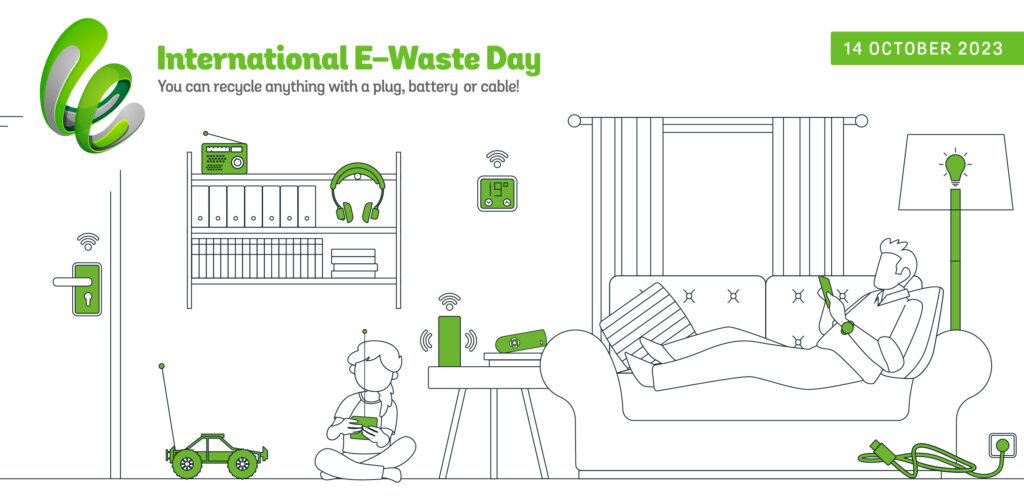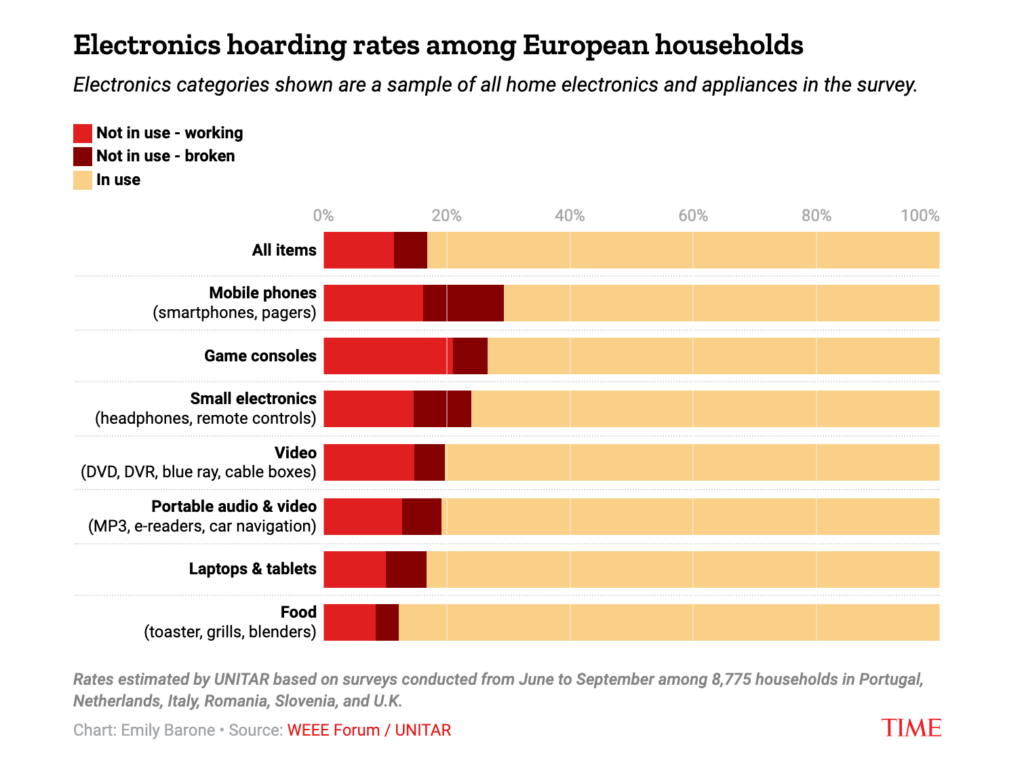
- “Invisible” e-waste was the key focus of this year’s International E-Waste Day.
- In 2023, 8kg of e-waste will be produced per person worldwide.
- The weight of all e-cig vapes discarded is the same as six Eiffel Towers.
The sixth annual International E-Waste Day was on October 14, focussing on “invisible” e-waste. Experts are sounding the alarm about consumers’ propensity to improperly dispose of electronic items that they might not even realize need to be treated like e-waste.
For every person on earth, one e-toy is tossed into landfills each year – that’s drones, talking dolls, remoted controlled cars and other childrens’ gadgets piling up. Most people know that e-waste includes electronics such as computers, smartphones, TVs and speaker systems.

Those light-up wings you wore at Glastonbury are invisible e-waste!
What they might not realize is that power tools, vapes, LED accessories, USB cables, anything involving rechargeable lithium batteries and countless other similar, “nontraditional” e-waste materials, need to be disposed of separately to general waste.
E-waste is the world’s fastest-growing waste stream. It isn’t all caused by lazy disposal of old phones and laptops: things like LED-decorated novelty clothes are invisible e-waste.
What’s meant by “invisible” e-waste? It’s what we call the electronic items that often go unrecognized and aren’t properly recycled within the appropriate waste stream. While e-waste is often associated with discarded gadgets and devices, a significant amount remains in plain sight – overlooked, not unseen!

LED-powered, extra high visibility hi-vis has to be recycled as e-waste, too!
Pascal Leroy, Director-General of the WEEE Forum pointed out, “invisible e-waste goes unnoticed due to its nature or appearance, leading consumers to overlook its recyclable potential.”
As today’s lifestyle is more and more technologically oriented, a lot of products present on the market have an electrical or electronic components.
Europe, which leads the world in e-waste recycling, still only sees 54% of e-waste officially reported as collected and recycled. Lack of public awareness is preventing countries from developing circular economies for electric equipment.
That’s why invisible e-waste was at the forefront of this year’s International E-Waste Day. The event is organized by the Waste Electrical and Electronic Equipment (WEEE) Forum. In anticipation of the event, WEEE commissioned the United Nations Institute for Training and Research (UNITAR) to delve into how much unconventional e-waste is discarded each year.
To draw attention to the growing issue of electronic waste, and to promote responsible e-waste management, this year’s edition of International E-Waste Day had the slogan “You can recycle anything with a plug, battery or cable!”

Source: WEEE Forum.
At the moment, people across the world throw out roughly 9 billion kilograms (19.8 billion pounds) of e-waste commonly not recognized as such by consumers.
The UN says that in 2023, 8kg of e-waste will be produced per person worldwide, meaning 61.3 million tons of electronic waste added to the world as a whole – that’s more than the Great Wall of China weighs.
Still struggling to get it? Imagine “loads and loads” and you’ll be halfway to the amount of e-waste being produced.
Only 17.4% of this waste, containing a mix of harmful substances and precious materials, will be recorded as properly collected, treated, and recycled globally.
According to the President of the WEEE Forum, Jan Vlak, “not only producers but all relevant actors, including regulators, consumers, refurbishers, reuse outfits, scrap dealers, retailers and recyclers, must play a role in the EPR system to successfully increase the collection of e-waste.”
The remaining 50.6 million tons will be either placed in landfill, burned, or illegally traded and treated in sub-standard conditions.
There’s one more place it might go: the Void of Invisibility – a multi-dimensional null-space which can include the back of your desk drawer, a cupboard in the spare room, the garage, basement, and even the attic. A study conducted in 2022 by UNITAR and WEEE Forum members in six countries (UK, Italy, Portugal, Romania, Slovenia and the Netherlands) found that of the 74 average total e-products in a household, 13 were hoarded (nine unused but working, four broken).
Examples of the type of objects in the Void include electric and electronic toys, e-cigarettes, power tools, smoke detectors, wearables, smart home gadgets, e-bikes and e-scooters and even just cables. Top of the list of hoarded items were headphones and remote controls.

Via Time.
The valuable resources that these items contain can’t re-enter the manufacturing cycle from the box marked ‘electrical’ in the garage. These resources, including precious metals like gold, silver, and copper, as well as rare and strategic elements (referred to as Critical Raw Materials) are crucial for the green transition and the production of new electronic devices.
Mining and extracting new resources to meet demand for electronics production, rather than reusing resources released from old devices, contributes to the depletion of finite resources and intensifies environmental damage.
More obviously ecologically damning, electronic devices and components improperly disposed of end up in landfills or incinerators. As well as valuables, electronics contain various hazardous materials such as lead, mercury, cadmium, and flame retardants, which can leach into soil and water sources, polluting ecosystems and posing risks to human health.
The amount of potentially toxic electronic waste produced annually—50 million tonnes—increases with humanity's desire for new technology.
But how much more can our planet take of machines designed to break?#EWasteDay pic.twitter.com/f1fuOL72sj
— UN Environment Programme (@UNEP) October 14, 2023
UNITAR’s findings also showed that the weight of all e-cig vapes thrown away each year roughly equals six Eiffel Towers. Combined with other types of invisible e-waste, the total weight of all electronic waste overlooked and discarded is “almost half a million 40 [metric] ton trucks.”
That’s enough to create a bumper-to-bumper traffic jam stretching approximately 3,504 miles–the distance between Rome and Nairobi. From a purely economic standpoint, nearly $10 billion in essential raw materials is literally thrown into the garbage every year.
European Commissioner for the Environment, Virginijus Sinkevičius, said that “This International E-Waste Day, the EU acknowledges the pressing e-waste challenge and is proactively setting a leadership example.”
International E-Waste Day serves as a platform for raising awareness about the e-waste issue. Last year, 194 organisations from 72 countries across 6 different continents registered as participants.
Correctly recycling your e-waste – visible and invisible – is increasingly a duty that falls on both individuals and companies. Find out what you do with your e-waste, and recycle it responsibly.











